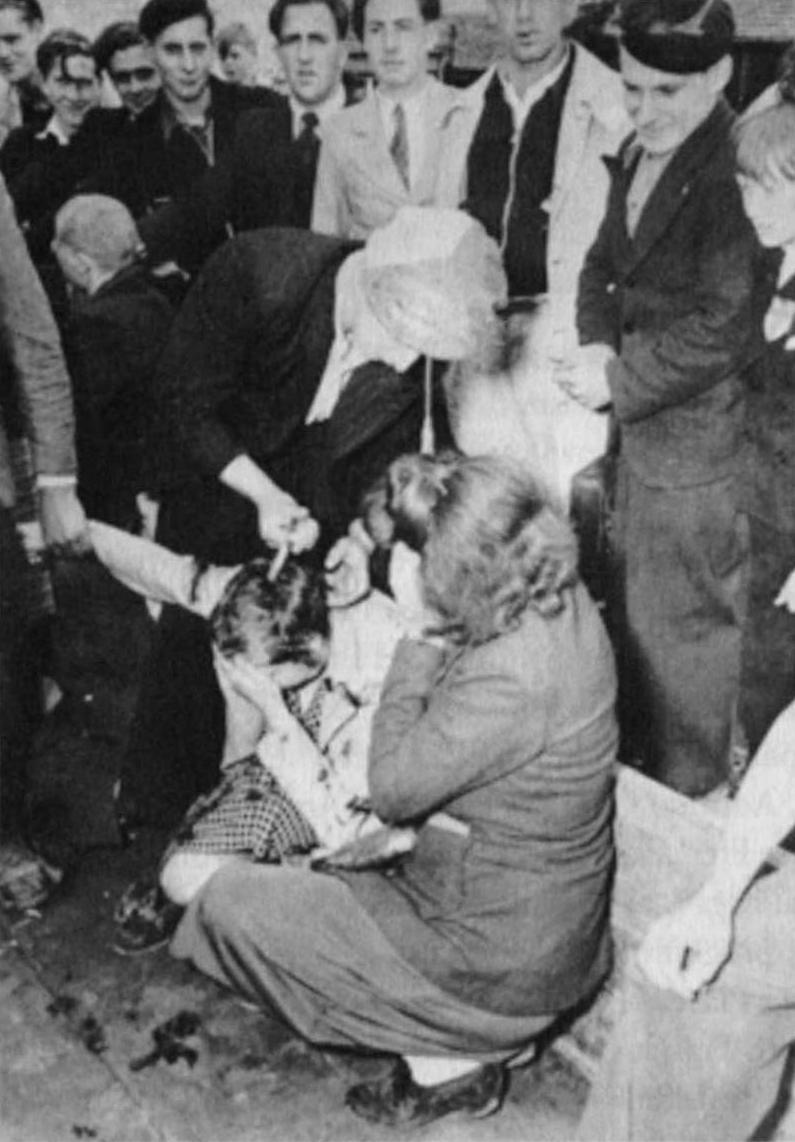
The Liberation of France: Dealing with Colaborators--Retribution

Figure 1.--Here women who associated with the Germans are having their hair cut off. Many were later shaved. Some 20,000 French women may have been subjected to this treatment. This action occurred in Cherbourg, an important port, after liberation. As was almost always the case, it was men who did the sheering. When they were then paraded ariund the town, women participated in the taunting and jeering.
|
|
In the heady days as American Sherman tanks rolled through village after villge liberating France there were joyous celebrations in the streets and town plazas. At the same time a wave of summary actions occurred, what the French now call the 'épuration sauvage'.) Armed Resistance groups sought out collaborators. This was a pricess that began clandestinely even during the occupation. There are no precise statistics available here. One French siurce suggests that the Resistance assasinated about 6,000 collaborators during the occupation. The Germans did not react with reprisals in the same way when Germans were killed. There were another estimated 4,000 executions in the immediate aftermath of liberation. The Communists who were particularly active in the armed resistance were responsible for many of these executions. Members of the Milicie were often targeted. Many women who had been involved with German soldiers at this time had their hair shaved publically or were otherwise publically humiliated. The hair cutting was done by men, but often women were cheering them on. One source suggests that this was the fate of some 20,000 young women. [Virgili, p. 52.] Their primary crime was liasons with German soldiers. Today in our more forgiving times, there us a tendency to excuse these women. Of course we havev not justv experienced NAZI occupation. Many today view these women were naive victims of the heart. In some cases this was the case. In other instances it was a matter of survuival, a way of obtaining food. Others were calculating women with no scruples. The issue can be argued endlessly. A French Provision Government was formed (August) and very quickly took action to prevent summary executions. [Lottman] Black marketeers were labeded war profiteers and also targeted. General DeGualle acted quickly to control the situation, even before the liberation of Paris. He issued ordinances on the judgment of collaborators by the commissions d'épuration (June 26-27, 1944). In thev immediate aftermath of liberation, these regulations could not be enforced. The Provisional Government of the French Republic (1944-46) dominated by the Guallists, however, raoidly assumed control . The French legal system took over, a legal system whichb incudentally had itself collaborated with the Germans. Punishuing collaborators moved into the Guallists Commissiions and eventually the more formal courts, Many were arrested and tried for collaboration after Liberation. The Guallists commissions found about 120,000 persons guity and sentencd them. This included a number of prominent figures. Officers of the Vichy Government were some of the primary targets of these procecutions. The Germans had brought leading figures back to the Reich, sone againstv their will (August 1944). Theyv were arrested their and brought back to France for procecution (July 1945). Admiral Darlan was sentenced to death. Marshall Petain was also sentenced to death by firing squad, but General de Gaulle commuted the sentence to life imprisonment. Charles Maurras, the leader of the royalist Action française was sentenced to life imprisonment (January 25, 1945) Author and anti-Semite Louis-Ferdinand Céline was named a collaborator and convicted in absentia (1950). The official French courts sentenced 6,763 people to death, mote than hald in in absentia (1944-51). The convictions were for treason and a varietybof other offences. French authorities only carried out 791 executions. More common punishments were 'national degradation'. This involved public disgrace and a loss of civil rights. Some 49,723 people received this sentence. [Judt, p. 46.] Attitudes in France changed considerably after the War. Officials of the Fourth French Republic (1946–54) began granting amnesty to many of those convicted.
Sources
Judt, Tony. Postwar: A History of Europe Since 1945 (Pimlico: London, 2007).
Lottman, Herbert R. The Purge: The Purification of French Collaborators after World War II.
Vergili, Fasbrice. Shorn Women: Gender and Punishment in Liberation France (Oxford, U.K.: Berg, 2002).
HBC

Navigate the Boys' Historical Clothing Web Site:
[Return to Main French dealing with collaborators page ]
[Return to Main liberation of France page]
[Return to Main Vichy page]
[Return to NAZI Lebensborn program--France]
[Return to World War II: France]
[Biographies]
[Campaigns]
[Children]
[Countries]
[Deciding factors]
[Diplomacy]
[Geo-political crisis]
[Economics]
[Home front]
[Intelligence]
[POWs]
[Resistance]
[Race]
[Refugees]
[Technology]
[Bibliographies]
[Contributions]
[FAQs]
[Images]
[Links]
[Registration]
[Tools]
[Return to Main World War II page]
[Return to Main war essay page]
Created: 7:12 PM 6/26/2013
Last updated: 7:12 PM 6/26/2013



